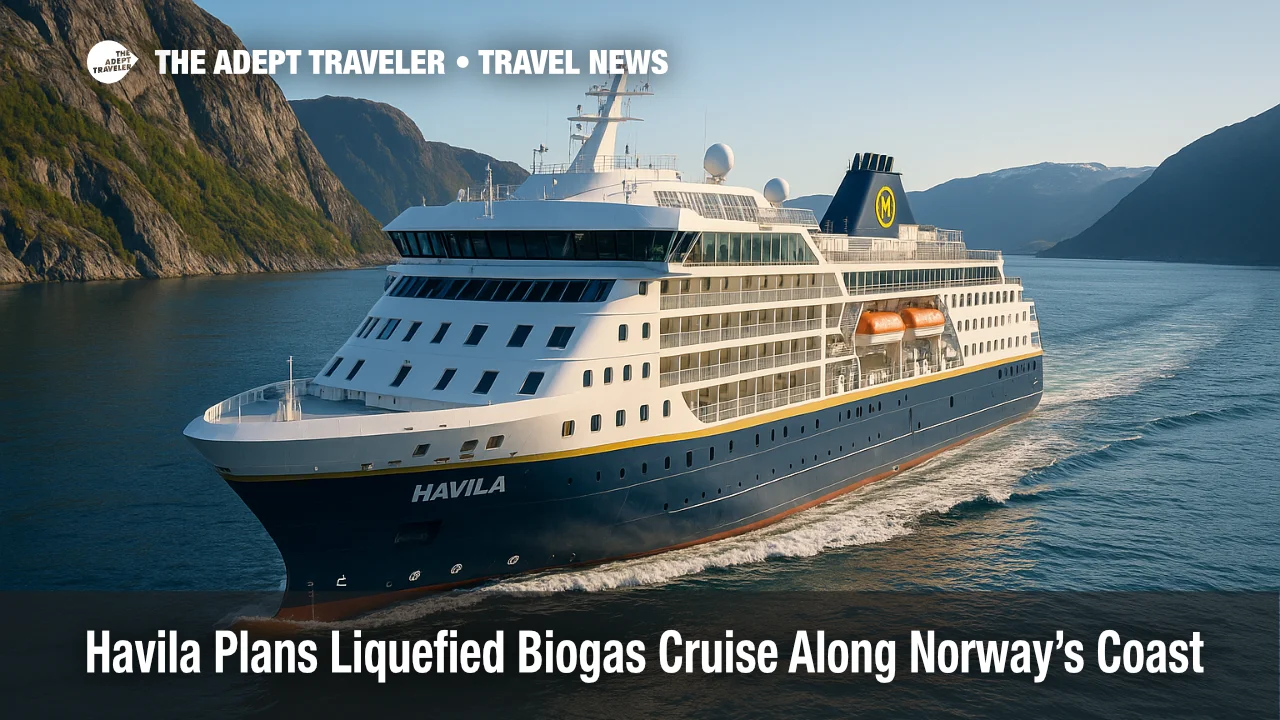Havila plans liquefied biogas cruise along Norway's coast

Havila Voyages will attempt a climate-neutral coastal voyage powered largely by liquefied biogas on Havila Polaris in late November, while rival Hurtigruten prepares a separate 100 percent biofuel sailing. Havila will bunker biogas near Hammerfest on November 26, then again in Bergen on November 30, combining the fuel with the ship's battery packs for a full round-trip on the Norwegian coastal route.
Key points
- Why it matters: Demonstrates climate-neutral coastal cruising with liquefied biogas.
- Travel impact: More low-emission options may appear on Norway itineraries if trials succeed.
- What's next: Authorities will set stricter requirements in the next coastal-route tender.
- Havila will take 200 m³ near Hammerfest on November 26, then 150 m³ in Bergen on November 30.
- Hurtigruten's MS Richard With departs October 29 on a 2,485-mile climate-neutral biofuel voyage.
Snapshot
Havila says the voyage aims to prove the entire coastal route can be operated climate-neutrally, which the company argues should be the minimum standard in the next government contract period. The liquefied biogas, supplied by Barents Naturgass and Molgas, is produced from organic waste streams such as food waste, manure, and fish sludge, and will be mixed with the natural gas already in the ship's tanks. Combined with large battery packs, Havila Polaris expects more than a 90 percent reduction in greenhouse-gas emissions for the trip. Hammerfest is remote; the nearest major city is Tromsø, roughly a short regional flight away, which helps explain the two-stage bunkering plan before and after arrival in Bergen.
Background
Norway's classic coastal express route links 34 ports from Bergen to Kirkenes. In recent years, both Havila Voyages and Hurtigruten have invested in cleaner propulsion, including LNG, hybrid batteries, and shore-power hookups at select ports. The government's next tender for the route is expected to tighten environmental criteria, and operators are using demonstration voyages to show they can meet stricter standards from day one. Havila previously renegotiated parts of its LNG supply to increase flexibility, and is now layering limited-availability biogas on top to test climate-neutral operations. Hurtigruten, for its part, plans a round trip departing October 29 with tanks filled entirely with advanced biofuel and shore-power use where available.
Latest developments
Liquefied biogas bunkering set for Hammerfest and Bergen
Havila Polaris will load approximately 200 cubic meters of liquefied biogas at Polarbase near Hammerfest on November 26, then sail to Bergen to take on an additional 150 cubic meters on November 30. The biogas will be blended with existing natural gas in the ship's tanks, and together with the vessel's battery parks is expected to power a complete round trip on the Norwegian coastal route with more than 90 percent lower greenhouse-gas emissions versus conventional fuels. CEO Bent Martini said the goal is to prove climate-neutral feasibility across the entire route and to encourage the state to require it in the upcoming tender period.
Hurtigruten readies 100 percent biofuel coastal sailing
On October 29, battery-hybrid MS Richard With will depart Bergen with tanks filled entirely with advanced biofuel for a 4,000-kilometer, climate-neutral round trip to Kirkenes and back. The voyage will connect to shore power where available. Hurtigruten's trial adds momentum to Norway's push for lower-emission coastal shipping and underscores growing supplier capacity for certified biofuels along the route.
Analysis
For travelers comparing Norway coastal voyages, these back-to-back trials are significant. Havila's liquefied biogas cruise tests a pathway that leverages limited biogas volumes blended with existing LNG infrastructure and sizable battery packs. That approach could scale gradually as biogas supply grows, especially in northern Norway where feedstocks like fish sludge and organic waste are abundant. Hurtigruten's 100 percent advanced biofuel sailing, by contrast, is a bolder, drop-in demonstration that requires robust certified sourcing and verification to claim climate neutrality, plus shore-power access at ports. Both models hinge on reliable low-carbon fuel logistics and verifiable lifecycle accounting. If authorities embed stricter climate terms in the next tender, these demonstrations show compliance is technically and operationally achievable now, not years from now. For guests, that could translate into more climate-neutral sailings, modest price premiums tied to fuel costs, and clearer emissions disclosures when choosing an itinerary.
Final thoughts
Norway's coastal operators are moving from incremental emissions cuts to full climate-neutral demonstrations. Whether via blended liquefied biogas plus batteries or 100 percent advanced biofuel, both strategies pressure-test supply chains and certification that future contracts will likely require. If outcomes match claims, expect more ports prepared for shore power, more certified biofuel availability, and clearer climate labeling in brochures. For travelers who prioritize sustainability without sacrificing scenery and schedule reliability, the emerging headline option to watch is the liquefied biogas cruise.
Sources
- Havila Voyages to sail climate-neutral and challenge government climate ambitions, Havila Voyages
- Hurtigruten sets date for groundbreaking 4000km climate-neutral biofuel sailing, Hurtigruten
- First climate-neutral sailings using biofuels set for the Norwegian coast, The Maritime Executive
- Havila to sail climate-neutral along Norwegian coast, Cruise Industry News
- Biogas milestone for Norway's coastal shipping, Travel Daily News
- Hurtigruten to sail 4,000km climate-neutral biofuel sailing, Cruise Industry News
